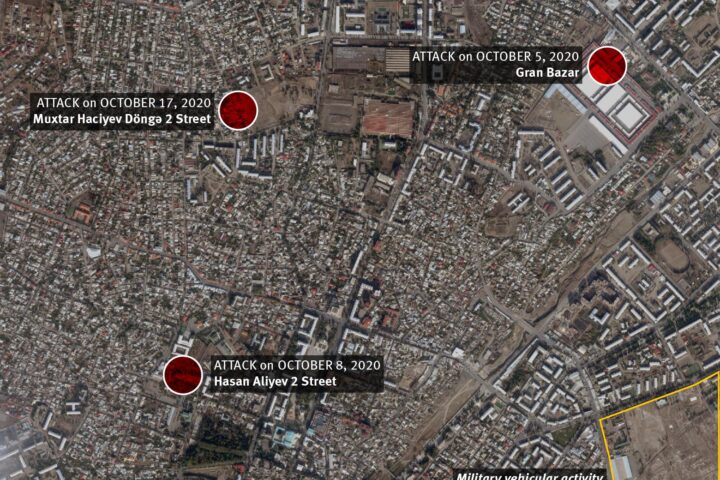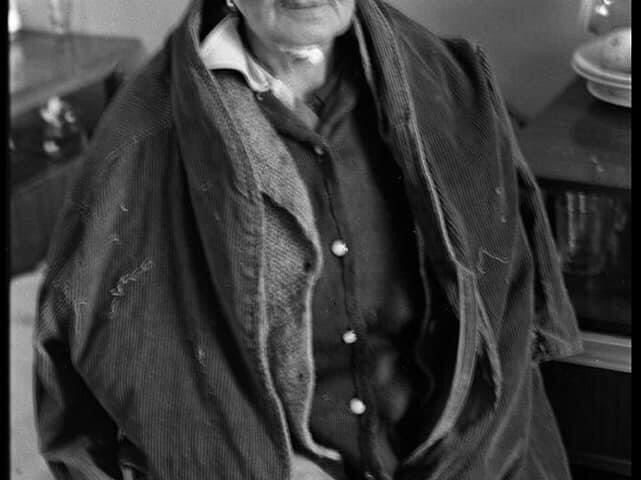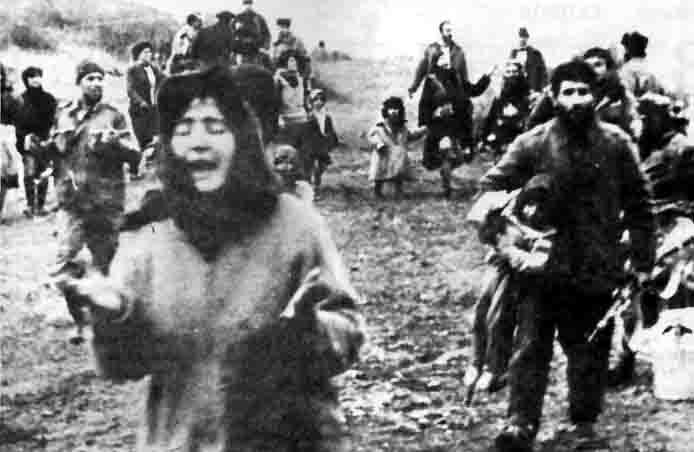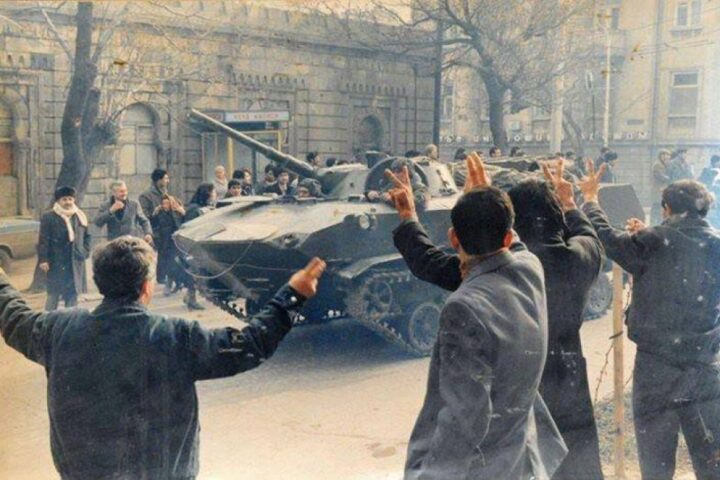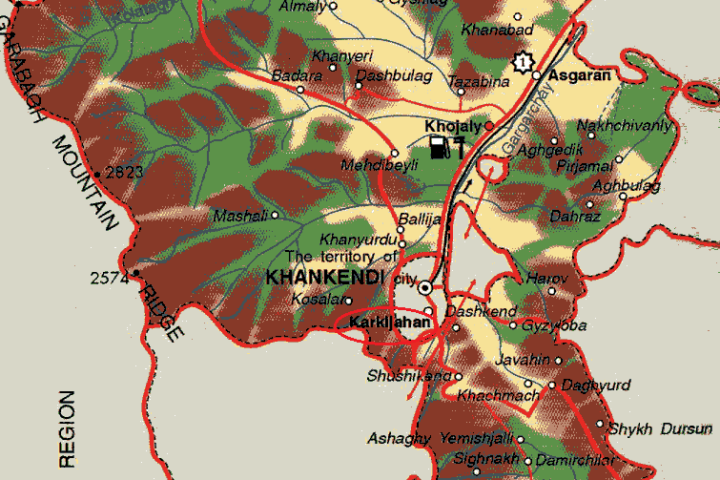Conclusion
The Karabakh region as a whole, and its mountainous part (NK), has been a historic part of Azerbaijan and populated by a majority Azerbaijani population for the past several centuries. The Armenian-speaking population became majority only in the 20th century, after an out migration of the Muslim (primarily Azerbaijani Turkic) population and settlement of ethnic Armenians from primarily the Iranian Empire in the 19th century in the mountainous part of the region. Despite intense lobbying and attempts to transfer NK to Armenian jurisdiction, the region was retained as part of Soviet Azerbaijan in the 1920s. However, a time-bomb was put in place by arbitrary delimitation of the mountainous Karabakh to include a maximum of Armenian-populated villages, and exclude Azerbaijani one’s, hence creating an “Armenian enclave” with a special autonomous status of an oblast’ (NKAO) – which while being lower than the status of the Autonomous Republic and Union Republic, favored the Armenian irredentism and separatist claims. Despite better quality of life and standards of living that on average in either Azerbaijan, Armenia or USSR as a whole, claims of economic deprivation and mistreatment were alleged early on, with swift reaction of central Soviet authorities, pressuring Azerbaijan to increase financial subsidies of NKAO even further, at the expense of truly depressed and overlooked regions of the republic. Despite continued Armenian efforts to show NK as being part of Azerbaijan only in Soviet times and succeeding in full conformity with the laws of the time, particularly the 3 April 1990 Law on Succession, the United Nations Security Council, along with all other relevant international organizations, recognized NK and all other currently Armenian-occupied regions as integral part of the independent Republic of Azerbaijan. The international community has also implicated and recognized Republic of Armenia as not only a supporter of local Armenian separatists, but as a country occupying territories of a neighboring state, but has not applied or approved any sanctions. Additionally, the international community, in what has been termed as the “Baker Rules”, has recognized only the Republic of Armenia and Republic of Azerbaijan as the “principal parties” to the NK conflict, whilst the two ethnic communities, including the self-proclaimed and unrecognized “NKR”, were recognized only as the “interested parties”.
[1] Some of the analysis was previously done in: Baguirov, Adil, Myths Related to the Nagorno-Karabakh Conflict, in: Azerbaijan International magazine, Media Watch, Vol. 6.1, (Spring 1998), http://www.azer.com/aiweb/categories/magazine/61_folder/61_articles/61_mediawatch.html
[2] U.S. Department of State, History of the Nagorno-Karabakh Conflict, (March 30, 2001), http://www.azer.com/aiweb/categories/karabakh/karabakh_current/keywest_history.html
[3] For the full list of all UN Security Council resolutions passed in 1993, see: http://www.un.org/Docs/scres/1993/scres93.htm
[4] UN General Assembly Resolution 49/13, forty-ninth session, agenda item 27, (November 25, 1994), http://www.un.org/gopher-data/ga/recs/49/9460075e.txt
[5] UN General Assembly Resolution 57/298, fifty-seventh session, agenda item 22 (I), (February 6, 2003), http://daccess-ods.un.org/access.nsf/Get?Open&DS=A/RES/57/298&Lang=E
[6] OSCE Lisbon Summit Final Documents, DOC.S/1/96, (3 December 1996), p. 15,
http://www.osce.org/item/4049.html
[7] OIC Secretary General’s Report On The Aggression of The Republic of Armenia Against The Republic of Azerbaijan, OIC/ICFM-33/POL/SG.REP.7, (2006),
http://www.oic-oci.org/baku2006/english/SG-report/SGREP-33ICFM-AZERBAIJAN-REV.doc; The Aggression of The Republic of Armenia Against The Republic of Azerbaijan, The Thirty-third Session of the Islamic Conference of Foreign Ministers, Session of Harmony of Rights, Freedoms, and Justice, Baku, (19-21 June 2006), http://www.un.int/azerbaijan/oic.php and http://www.oic2006baku.gov.az/eng/resolutions/armenian_aggression.shtml
[8] Atkinson, David, United Kingdom, European Democrat Group, (Rapporteur), The conflict over the Nagorno-Karabakh region dealt with by the OSCE Minsk Conference, Parliamentary Assembly of the Council of Europe (PACE), (29 November 2004), http://assembly.coe.int/Documents/WorkingDocs/doc04/EDOC10364.htm
[9] PACE Resolution 1416: The conflict over the Nagorno-Karabakh region dealt with by the OSCE Minsk Conference adopted by the Parliamentary Assembly of the Council of Europe, (25 January 2005), http://assembly.coe.int/Documents/AdoptedText/TA05/ERES1416.htm
[10] U.S. Department of State, The United States and the Conflict Over Nagorno-Karabakh, Fact Sheet, Bureau of European and Eurasian Affairs, Washington, DC, February 7, 2005, http://www.state.gov/p/eur/rls/fs/41401.htm
[11] UK Government, UK and Azerbaijan ‘reaffirm declaration of friendship and co-operation’, (15 December 2004), http://www.number-10.gov.uk/output/page6776.asp
[12] MFA of Russian Federation, Комментарий Департамента информации и печати МИД России в связи с прошедшими недавно в Нагорном Карабахе “парламентскими выборами”, Департамента информации и печати МИД России, Doc. 1417-22-06-2005, (June 22, 2005), http://www.mid.ru/Brp_4.nsf/arh/FE4FBA95FEBDC55FC32570280048D43B?OpenDocument
[13] Population statistics is based on the figures from the following sources, in order of appearance: Cornell, Svante, “Small Nations and Great Powers: A Study of Ethnopolitical Conflict in the Caucasus”, Surrey, England: RoutledgeCurzon Press, (2001), p. 68, and Присоединение Восточной Армении к России, Ереван, 1972, с. 562; Cornell, ibid. Also see: Swietochowski, Tadeusz, “Russia and Azerbaijan, a Borderland in Transition”, New York: Columbia University Press, (1995), p. 11, and Сборник сведений о Кавказе, т. 7, Тифлис, 1873; Altstadt, Audrey, “The Azerbaijani Turks: power and identity under the Russian rule”, Stanford: Hoover Institution Press, (1992), p. 30, table 3.1, Imperial Census of 1897; Джамал, Caxиб, Карабахская Хроника (реконструкция этнической истории Карабаха по архивным материалам (1805-1905 гг.)), in: IRS journal, №7, (2003), http://www.irs-az.com/gen/n7/n7_11.htm Hovannisian, Richard, The Armeno-Azerbaijani Conflict over Mountainous Karabagh, 1918-1919, in: The Armenian Review, Vol. 24, 2-94, (Summer 1971), p. 5; Ibid., p. 4-5, footnote 4;
Soviet population census of 1926 (in Russian), Wikipedia, http://ru.wikipedia.org/wiki/Всесоюзная_перепись_
населения_СССР_1926_года (accessed October 2007); De Waal, Thomas. “Black Garden: Armenia and Azerbaijan through Peace and War”. New York: New York University Press, (2003), p. 130;
Численность и состав населения СССР (по данным переписи населения 1979 года), М., Финансы и статистика, 1985; Human Rights Watch, “Seven Years of Conflict in Nagorno-Karabakh”, printed in USA by Human Rights Watch / Helsinki, (December 1994), p. xiii, ISBN 1-56432-142-8, citing: Natsional’nyi Sostav Naseleniya SSSR, po dannym Vsesoyuznyi Perepisi Naseleniya 1989 g., Moskva, “Finansy i Statistika”; Yunusov, Arif, Armenian-Azerbaijani Conflict: Demographic and Migratory Aspects, in: Central Asia and Caucasus Journal, #16, (1998), http://www.ca-c.org/journal/16-1998/st_10_junusov.shtml
[14] ANCA Press Release, ANCA criticizes State Department statement describing the Nagorno Karabagh republic as “criminal secessionists”. Incendiary Remarks by Assistant Secretary of State Jones Undermine the Karabagh Peace Process, Washington D.C., (January 18, 2005), http://www.anca.org/press_releases/press_releases.php?prid=698
[15] Russian State Archive of Socio-Political History (Moscow), f.64, op. 2, d.1, p.118, 121-122. A facsimile of the actual archival copy from the Azerbaijani State History archive is at the disposal of this author.
[16] Altstadt, Audrey. “Azerbaijan Turks: Power and identity under Russian Rule”, Stanford: Hoover Institution Press, (1992), p. 102.
[17] Central Party Archive of the Institute of Marxism-Leninism of the CC CPSU (Moscow), f. 461, op. 1, report #45252, p. 1. Note that all archival references are given by their original, Soviet names of the archives, which have since changed.
[18] Central State Archive of October revolution of Azerbaijan SSR (Baku), f. 410, op. 2, d. 69, pp. 181-187.
[19] U.S. Department of State, Criteria For U.S. Assistance Under Section 498a(A) Of The Foreign Assistance Act. Armenia. U.S. Government Assistance to and Cooperative Activities with Eurasia – FY 2003, Released by the Bureau of European and Eurasian Affairs, (January 2004), http://www.state.gov/p/eur/rls/rpt/c13148.htm
[20] U.S. Presidential Determination (PD) No. 99-8 of December 8, 1998, and PD No. 98-11 of January 26, 1998, Memorandum for the Secretary of State, Re: “Assistance Program for the New Independent States of the Former Soviet Union”, The White House, Washington D.C., (1998).
[21] Report of the OSCE Fact-Finding Mission (FFM) to the Occupied Territories of Azerbaijan Surrounding Nagorno-Karabakh (NK), Website of the European Parliament, (28 February 2005), http://www.europarl.europa.eu/meetdocs/2004_2009/documents/fd/dsca20050413_08/dsca20050413_08en.pdf
[22] “Expert Contrasts Armenia, Azerbaijan Development”, FBIS-translated item WA182000106, Baku, “BAKINSKIY RABOCHIY” newspaper, in Russian, (11 March 1988), pp. 2-3.
[23] Ibid.
[24] Council of Europe, ACFC/SR (2002) 1, Report Submitted By Azerbaijan Pursuant To Article 25, Paragraph 1 Of The Framework Convention For The Protection Of National Minorities, (received on 4 June 2002), http://www.humanrights.coe.int/minorities/Eng/FrameworkConvention/StateReports/2002/azerbaijan.htm
[25] Table reproduced from: “Expert Contrasts Armenia, Azerbaijan Development”, FBIS-translated item WA182000106, Baku, “BAKINSKIY RABOCHIY” newspaper, in Russian, (11 March 1988), pp. 2-3.
[26] Maresca, John J, “Resolving the Conflict Over Nagorno-Karabakh: Lost Opportunities for International Conflict Resolution”, In Chester A. Crocker, Fen Osler Hampson and Pamela Aall (eds) Managing Global Chaos: Sources of and Responses to International Conflict, p. 260. Washington D.C.: United States Institute of Peace Press, (1996)
[27] “Law on Procedures for Resolving Questions Related to the Secession of Union Republics from the USSR (3 April 1990)”, in Hurst Hannum (ed.), Documents on Autonomy and Minority Rights, pp. 753-760, London: Martinus Nijhoff Press, (1993)
[28] “A Blueprint for Resolving the Nagorno-Karabagh Crisis,” New England Center for International Law and Policy and the Public International Law and Policy Group, (June 2000), http://www.nesl.edu/center/pubs/nagorno.pdf
[29] Kučinskas, Linas, Lithuania’s Independence: The Litmus Test For Democracy In The U.S.S.R., in: Lithuanian Quarterly Journal Of Arts And Sciences (Lituanus), Volume 37, No.3, (Fall 1991), ISSN 0024-5089, http://www.lituanus.org/1991_3/91_3_01.htm
[30] The official Azerbaijani position is found here: Ministry of Foreign Affairs of the Republic of Azerbaijan, “Legal aspects of the Nagorno-Karabakh conflict”, accessed November 2007, http://www.mfa.gov.az/eng/armenian_aggresion/legal/index.shtml
The official Armenian view is here: Nagorno Karabagh A White Paper, The Armenian Center for National and International Studies, Yerevan, Armenia. Publication sponsored by the Armenian Assembly of America, Washington, D.C., (March 1997), http://www.ArmeniaForeignMinistry.com/fr/nk/white_paper.html
[31] Constitution (Fundamental Law) Of The Union Of Soviet Socialist Republics, Adopted at the Seventh (Special) Session of the Supreme Soviet of the USSR Ninth Convocation On October 7, 1977. Translation by official Novosti Press Agency Publishing House, Moscow, (1985) (split into 7 parts by Bucknell University, consisting of 174 articles), http://www.departments.bucknell.edu/russian/const/1977toc.html
[32] Ibid. Articles 70-88 can be read here: http://www.departments.bucknell.edu/russian/const/77cons03.html
[33] Parliamentary Assembly of the Council of Europe, Background paper on the Nagorno-Karabakh conflict, prepared by the Directorate General of Political Affairs for the seminar ‘Youth and conflict resolution’, Strasbourg, (31 March – 2 April 2003), http://www.coe.int/t/e/com/files/events/2003-04-Youth-conflicts/Nagorno_conflict.asp
[34] ПОСТАНОВЛЕНИЕ от 13 марта 1992 г. N 3-П. “По делу о проверке конституционности Декларации о государственном суверенитете Татарской ССР от 30 августа 1990 года, Закона Татарской ССР от 18 апреля 1991 года “Об изменениях и дополнениях Конституции (Основного Закона) Татарской ССР”, Закона Татарской ССР от 29 ноября 1991 года “О референдуме Татарской ССР”, постановления Верховного Совета Республики Татарстан от 21 февраля 1992 года “О проведении референдума Республики Татарстан по вопросу о государственном статусе Республики Татарстан”, http://www.ksrf.ru/doc/postanrtf/p3_92.rtf and also here: http://www.eurolawco.ru/publ/ccrf31.html
[35] See, for example, the statements, articles and declarations in Russian of pro-independence Chechen activists: А. Закаев, Я. Чагаев, “Некоторые замечания к вопросу о легитимности Чеченской независимости”, Чеченпресс, 17.08.04, http://www.chechenpress.info/events/2005/04/29/30.shtml ; Идигов, Ахъяд, Председатель Парламента ЧР-Ичкерия (1993-1997 гг.), Отдел политической информации Chechenews.com, (06.09.2006), http://www.chechenews.com/events/2006/09/06/02.shtml ; Бадалов, Руслан, председатель регионального общественного движения Чеченский комитет национального спасения, “У нас уже есть одна Конституция. Другой не надо”, in: Время МН, N 43 (дайджест публикаций центральной прессы N 51 (589), 21 марта 2003 года), http://www.hro.org/editions/press/0303/21/21030336.htm. Then, compare with a retort from a pro-Federal Chechen expert: Султыгов, Абдул-Хаким, “Правовые проблемы чеченского национально-государственного самоопределения”, in: Елена Боннэр, Дмитрий Фурман и Юрий Самодуров (eds) Чечня и Россия – заложники друг у друга, Общественный центр имени Андрея Сахарова, (22 October 1999), Москва, http://www.sakharov-center.ru/chs/chrus17_1.htm
[36] For some more background info, see these articles in Russian: Госдума не разрешила иностранным автономиям самовольно переходить в состав России, (11.03.2005), http://www.vcj.ru/rus/news/2005/03/11/subject/ and: Ratiani, Natali. “Родина” расширяет границы. Дмитрий Рогозин Хочет Присоединить К России Немного Бывшей Советской Родины, in: Газета “Известия”, (10.03.2005), http://www.rodina-duma.ru/press/?page=17 and http://www.vibori.ru/news/2005/3/11.htm
[no_toc]




